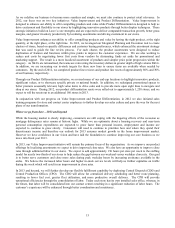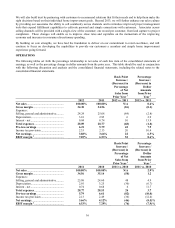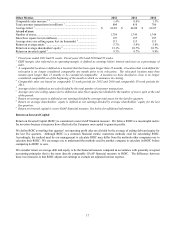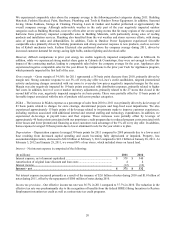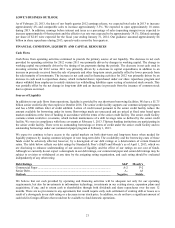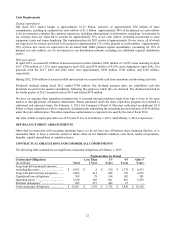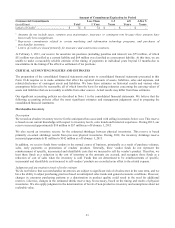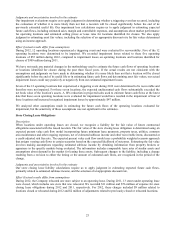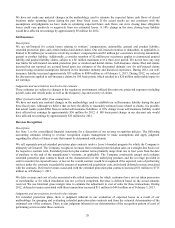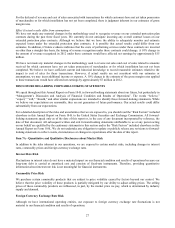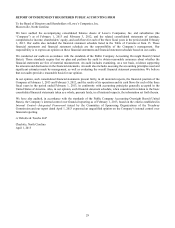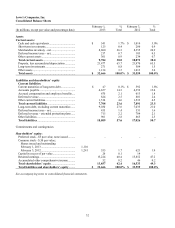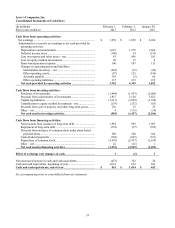Lowe's 2012 Annual Report Download - page 38
Download and view the complete annual report
Please find page 38 of the 2012 Lowe's annual report below. You can navigate through the pages in the report by either clicking on the pages listed below, or by using the keyword search tool below to find specific information within the annual report.24
For vendor funds, we develop accrual rates based on the provisions of the agreements in place. Due to the complexity and
diversity of the individual vendor agreements, we perform analyses and review historical purchase trends and volumes
throughout the year, adjust accrual rates as appropriate and confirm actual amounts with select vendors to ensure the
amounts earned are appropriately recorded. Amounts accrued throughout the year could be impacted if actual purchase
volumes differ from projected purchase volumes, especially in the case of programs that provide for increased funding
when graduated purchase volumes are met.
Effect if actual results differ from assumptions
We have not made any material changes in the methodology used to establish our inventory valuation or the related
reserves for obsolete inventory or inventory shrinkage during the past three fiscal years. We believe that we have sufficient
current and historical knowledge to record reasonable estimates for both of these inventory reserves. However, it is
possible that actual results could differ from recorded reserves. A 10% change in either the amount of products considered
obsolete or the weighted average estimated loss rate used in the calculation of our obsolete inventory reserve would have
affected net earnings by approximately $3 million for 2012. A 10% change in the estimated shrinkage rate included in the
calculation of our inventory shrinkage reserve would have affected net earnings by approximately $9 million for 2012.
We have not made any material changes in the methodology used to recognize vendor funds during the past three fiscal
years. If actual results are not consistent with the assumptions and estimates used, we could be exposed to additional
adjustments that could positively or negatively impact gross margin and inventory. However, substantially all receivables
associated with these activities do not require subjective long-term estimates because they are collected within the
following fiscal year. Adjustments to gross margin and inventory in the following fiscal year have historically not been
material.
Long-Lived Asset Impairment
Description
We review the carrying amounts of locations whenever certain events or changes in circumstances indicate that the
carrying amounts may not be recoverable. When evaluating locations for impairment, our asset group is at an individual
location level, as that is the lowest level for which cash flows are identifiable. Cash flows for individual locations do not
include an allocation of corporate overhead.
We evaluate locations for triggering events relating to long-lived asset impairment on a quarterly basis to determine when a
location’s asset carrying values may not be recoverable. For operating locations, our primary indicator that asset carrying
values may not be recoverable is consistently negative cash flow for a 12-month period for those locations that have been
open in the same location for a sufficient period of time to allow for meaningful analysis of ongoing operating results.
Management also monitors other factors when evaluating operating locations for impairment, including individual
locations’ execution of their operating plans and local market conditions, including incursion, which is the opening of
either other Lowe’s locations or those of a direct competitor within the same market. We also consider there to be a
triggering event when there is a current expectation that it is more likely than not that a given location will be closed
significantly before the end of its previously estimated useful life.
A potential impairment has occurred if projected future undiscounted cash flows expected to result from the use and
eventual disposition of the location’s assets are less than the carrying amount of the assets. When determining the stream of
projected future cash flows associated with an individual operating location, management makes assumptions,
incorporating local market conditions, about key store variables including sales growth rates, gross margin and controllable
expenses, such as store payroll and occupancy expense, as well as asset residual values or lease rates. An impairment loss
is recognized when the carrying amount of the operating location is not recoverable and exceeds its fair value.
We use an income approach to determine the fair value of our individual operating locations, which requires discounting
projected future cash flows. This involves making assumptions regarding both a location’s future cash flows, as described
above, and an appropriate discount rate to determine the present value of those future cash flows. We discount our cash
flow estimates at a rate commensurate with the risk that selected market participants would assign to the cash flows. The
selected market participants represent a group of other retailers with a market footprint similar in size to ours.
We use a market approach to determine the fair value of our individual locations identified for closure. This involves
making assumptions regarding the estimated selling prices or estimated lease rates by obtaining information from property
brokers or appraisers in the specific markets being evaluated. The information includes comparable sales of similar assets
and assumptions about demand in the market for purchase or lease of these assets.



